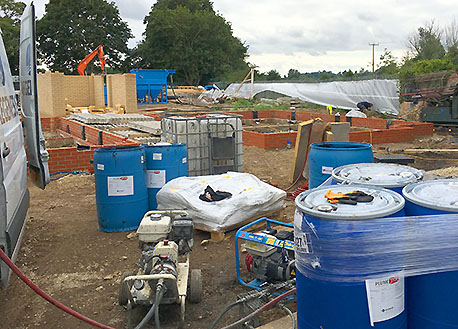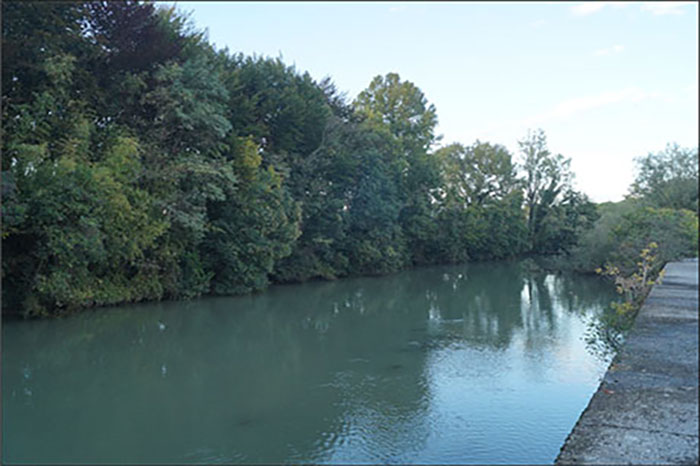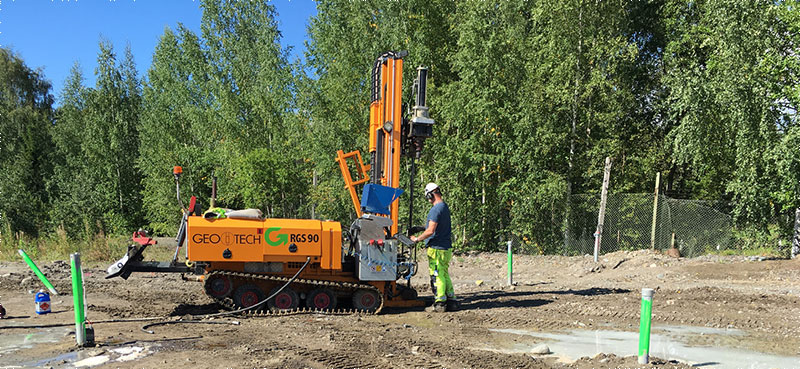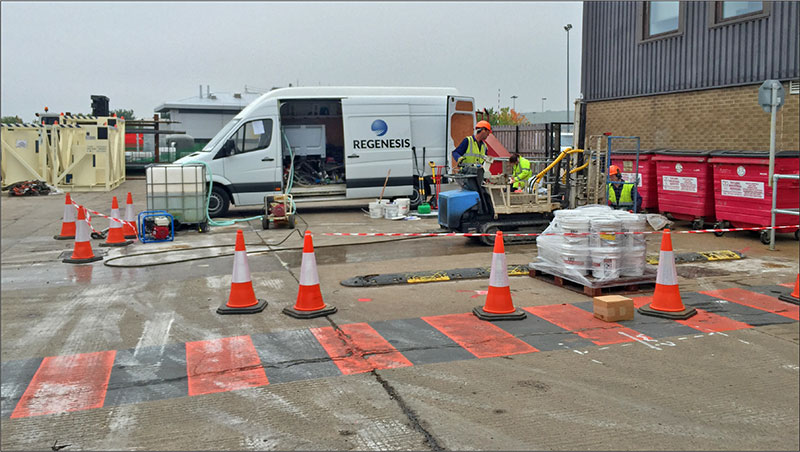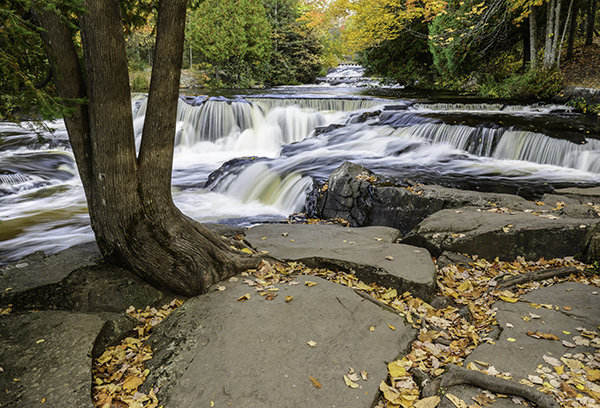Significant Reduction in VOCs Achieved at Rail Site
 This case study reviews a contaminated rail site in Canada that had released chlorinated solvents in groundwater. WSP conducted a pilot test at the site to assess the applicability of a brand-new technology that optimizes delivery of amendments using hydrocolloids. The pilot test would determine the applicability of a passive treatment barrier using PlumeStop and AquaZVI. A combined remedy approach was chosen because it optimizes the use of colloidal activated carbon and zero valent iron, allowing for the highest treatment efficiency at the lowest possible cost. After conducting the pilot test, data for samples collected within the treatment barrier indicated significant contaminant concentration decreases in groundwater and saturated soil.
This case study reviews a contaminated rail site in Canada that had released chlorinated solvents in groundwater. WSP conducted a pilot test at the site to assess the applicability of a brand-new technology that optimizes delivery of amendments using hydrocolloids. The pilot test would determine the applicability of a passive treatment barrier using PlumeStop and AquaZVI. A combined remedy approach was chosen because it optimizes the use of colloidal activated carbon and zero valent iron, allowing for the highest treatment efficiency at the lowest possible cost. After conducting the pilot test, data for samples collected within the treatment barrier indicated significant contaminant concentration decreases in groundwater and saturated soil.
This case study features the following:
- First application of PlumeStop® and AquaZVI™ globally
- Despite wintery weather conditions at the Rail Site in Northern Quebec, the amendment delivery and distribution was successful
- Over 95% decrease in dissolved and saturated soil VOC concentrations
- Thorough data analysis including ISMs and CSIA confirmed definite contaminant degradation
6m 9s reading time
Former Taxi Maintenance Site Successfully Treated with Enhance d Anaerobic Biodegradation and Bioaugmentation
Project Highlights
- Combined introduction of HRC® hydrogen release compounds and BDI Plus® bioaugmentation cultures resulted in reduction in chlorinated solvent concentrations, meeting site goals
- Successful remediation permitted redevelopment of the site into an elementary school
Project Summary
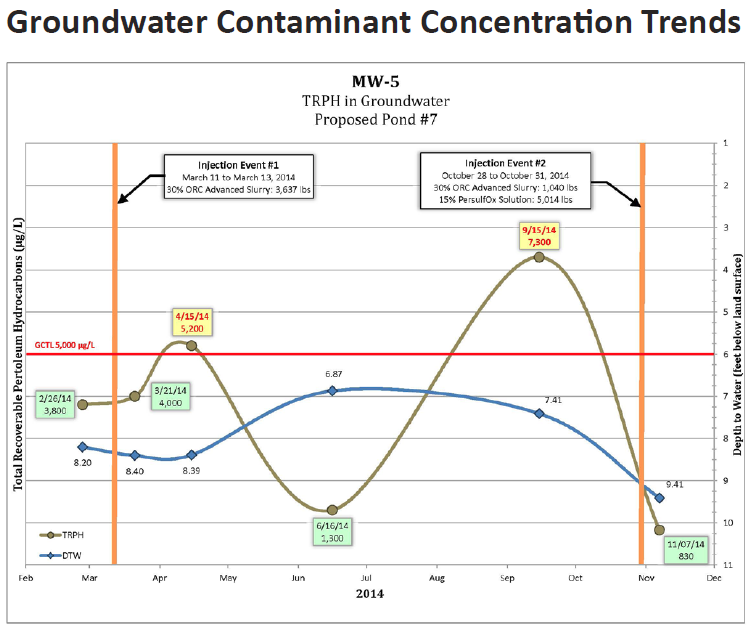
A former taxi maintenence facility located in Los Angeles, California was used as a garage and maintenance facility containing seven underground storage tanks (USTs), four hydraulic hoists, an elevator, a clarifier, and a spray paint booth. Environmental assessment related to the planned redevelopment of the garage and nearby commercial properties and residences revealed contamination of the soil and groundwater beneath the site with trichloroethene (TCE) and 1,2-dichloroethene (1,2-DCE) due to release from the former USTs and paint shop areas.
Under the jurisdiction of the California Department of Toxic Substance Control, an enhanced anaerobic biodegradation approach in conjunction with bioaugmentation was developed to remediate the chlorinated solvent contamination. This approach combined the introduction of the dechlorinating microcosm BDI Plus® with the application of supporting hydrogen release compounds 3-D Microemulsion® and HRC Primer®. Following treatment of the site, reduction in TCE and 1,2-DCE concentrations have been observed after four quarters of postremediation monitoring. Microbial data supports the benefits of the bioaugmentation effort by showing a steep increase in dehalococcoides populations, which increased by nearly four orders of magnitude. In addition, all geochemical parameters are in range for a reductive state.
Technology Description
3-D Microemulsion is an engineered electron donor material that offers a novel three-stage electron donor release profile, pH neutral chemistry, and is delivered on-site as a factory-emulsified product.
HRC Primer is derivative of the standard Hydrogen Release Compound product and is designed to provide a controlled but fast release of hydrogen to assist in initiating anaerobic biodegradation.
Bio-Dechlor INOCULUM Plus (BDI Plus) is an enriched natural microbial consortium containing species of Dehalococcoides sp. (DHC). This microbial consortium has since been enriched to increase its ability to rapidly dechlorinate contaminants during in situ bioremediation processes.
Results
Reduction of TCE and 1,2-DCE concentrations by enhanced anaerobic biodegradation and bioaugmentation facilitated the redevelopment of a former taxi garage and maintenance facility. Following a reduction in contaminant concentrations, the site was redeveloped to an elementary school.
45s reading time
Redevelopment of former gas works unlocked by combining technologies
Integrated remediation strategy provides rapid and cost-effective clean up
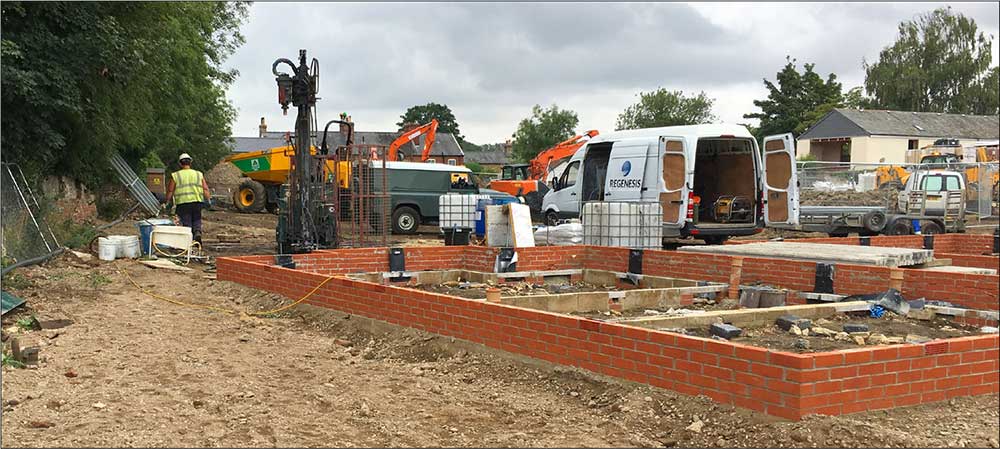
- During the construction of multiple residential dwelling it became apparent that a historical gas works had previously occupied the site.
- A targeted site investigation needed to be completed quickly to identify the areas requiring remedial action, enabling construction to continue in plots outside of the plume.
- A combined remedial strategy was required to address soil, LNAPL, DNAPL and dissolved phase contamination.
- The implementation of the treatment had to be completed around partially completed housing and live underground services.
- The remedial works had to be completed quickly in a manner as to not impact the build program.
- The strategy needed to provide appropriate protection to both human health and controlled waters.
- The need to respond and act quickly required excellent communication and good working relationships to be established between the consultant, stakeholders, regulators and multiple specialist remediation contractors and suppliers.
4m 44s reading time
Remedial Approach
A wide range of remediation technologies were deployed sequentially and in parallel to provide the most rapid and cost effective clean up:
- Ex situ bio-piling of hydrocarbon impacted soils
- LNAPL skimming
- Pump and treat (P&T) of dissolved phase contamination
- DNAPL pumping and settlement/collection
- Enhanced abstraction of contaminant mass using PetroCleanze
- In Situ chemical oxidation (ISCO) using RegenOx, which is compatible with footings and services already in place
- Accelerated aerobic natural attenuation using ORC Advanced slurry
- Accelerated aerobic natural attenuation using a pelletised oxygen-release compound (ORC Advanced) placed in the backfill
- PlumeStop Liquid Activated Carbon injection to install a subsurface activated carbon filter to adsorb and biologically degrade dissolved phase contamination
- Gas vapour membrane installation
Ex situ treatment
The impacted materials within the unsaturated zones within Plume A and B were excavated and placed in a biopile for onsite treatment (Figure 1). Nutrients were added and the biopile was turned until remedial targets were achieved. The soils were then backfilled under the CL:AIRE Code of Practice. Prior to backfill with the remediated soils, ORC Advanced Pellets were added to the base of the excavation. This provided a source of dissolved oxygen for up to a year, stimulating the growth of an effective aerobic biomass and accelerating the degradation of the petroleum hydrocarbon contamination.
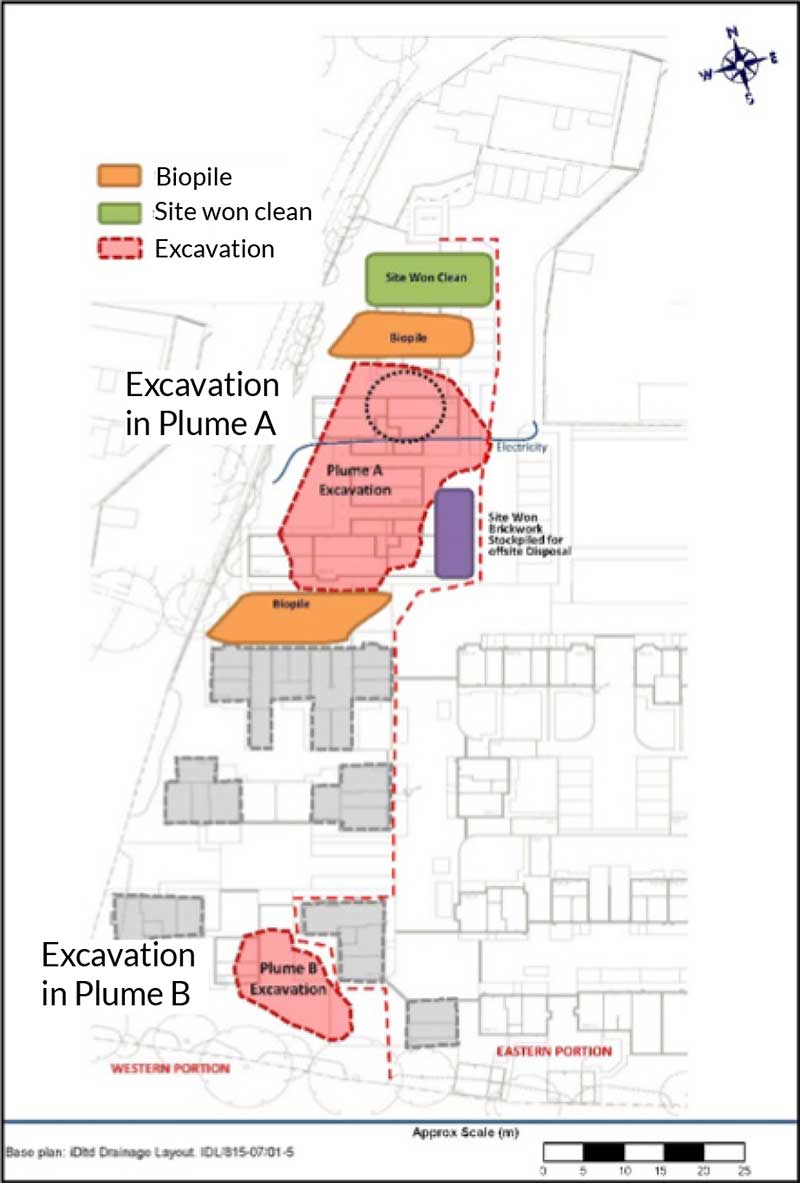
In Situ Treatment
The southern part of Plume A was made inaccessible by footings and services; here in-situ treatment was completed accommodate these obstructions without compromising treatment efficacy. Within Plume B, where high levels of contamination had been encountered (Figure 2), several in situ remedial actions were taken as appropriate to concentration, location and sequence in the strategy:
- REGENESIS injected PlumeStop, a micron-scale colloidal Liquid Activated Carbon substrate along the western margin of the site via direct push to protect the offsite surface water. PlumeStop creates a subsurface activated carbon filter which adsorbs the contaminant influx, which is then degraded by the microbial growth on the carbon biomatrix. Biological degradation was also accelerated through co-application of ORC Advanced and the presence of the pelletised ORC placed in the base of the excavation upgradient, providing a controlled release of oxygen.
- Where LNAPL and high dissolved phase concentrations were observed, a network of injection boreholes were installed by Rake Remediation/REGENESIS. Many of the wells were installed by removing suspended floors and lifting in a mini-rig to complete the drilling beneath partially constructed dwellings. Through these wells, multiple applications of RegenOx were completed. This in situ chemical oxidant was chosen as it was safe to handle on this busy site and would not corrode services installed at the site, nor would it be detrimental to the concrete footings.
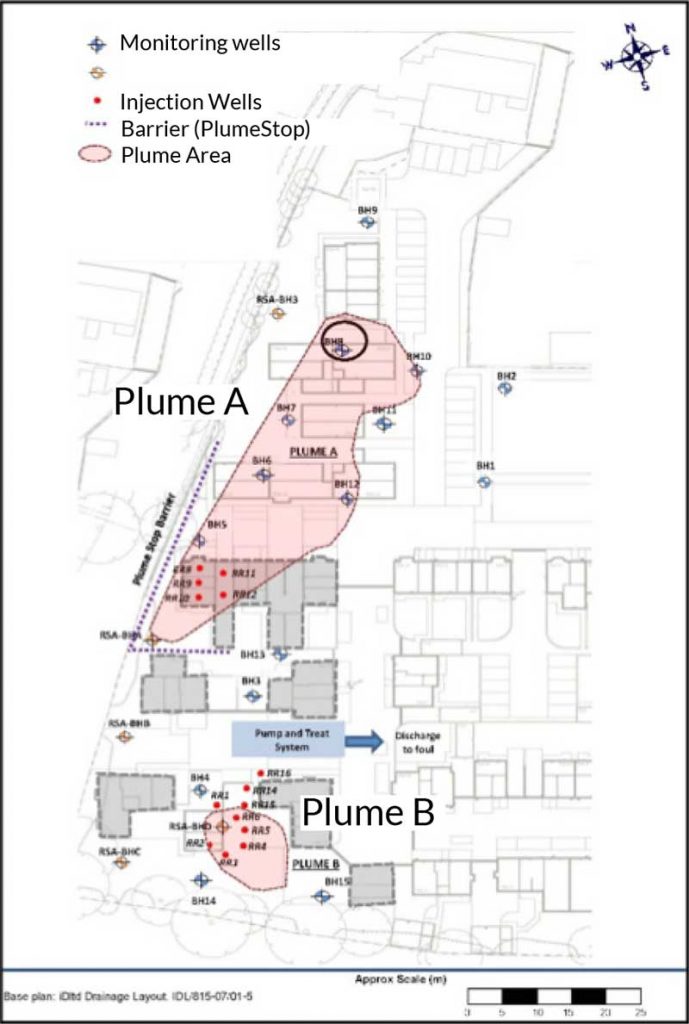
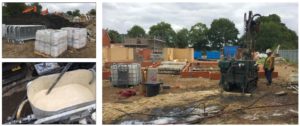
- Following the ISCO, ORC Advanced slurry was injected to enhance the natural attenuation (ENA) of the residual dissolved phase contamination to low levels.
- In Plume B, high levels of contamination in the form of both L- and DNAPL were encountered. This was removed using a P&T system augmented with PetroCleanze, an inorganic surfactant that uses a high pH, carbonates, silicates and partial oxidation to remove contaminants from soils. The PetroCleanze was injected to produce a temporary desorption event, which once observed, allowed the P&T system to be switched back for a short period to remove the contamination. This process was repeated three times to maximise the efficacy of the P&T and shorten the treatment programme.
- Once the NAPL was removed, multiple rounds of RegenOx were completed, followed by ORC Advanced via injection through wells.
- Long term groundwater monitoring programme was put in place to monitor the effectiveness of the clean-up.
Results
The following graphs (Figures 7 and 8) show the variations in concentrations for selected priority contaminants of concern over the monitoring period for Plume A and B. These show a marked reduction in the hydrocarbon dissolved phase concentrations over time, with compliance achieved with the remedial criteria.
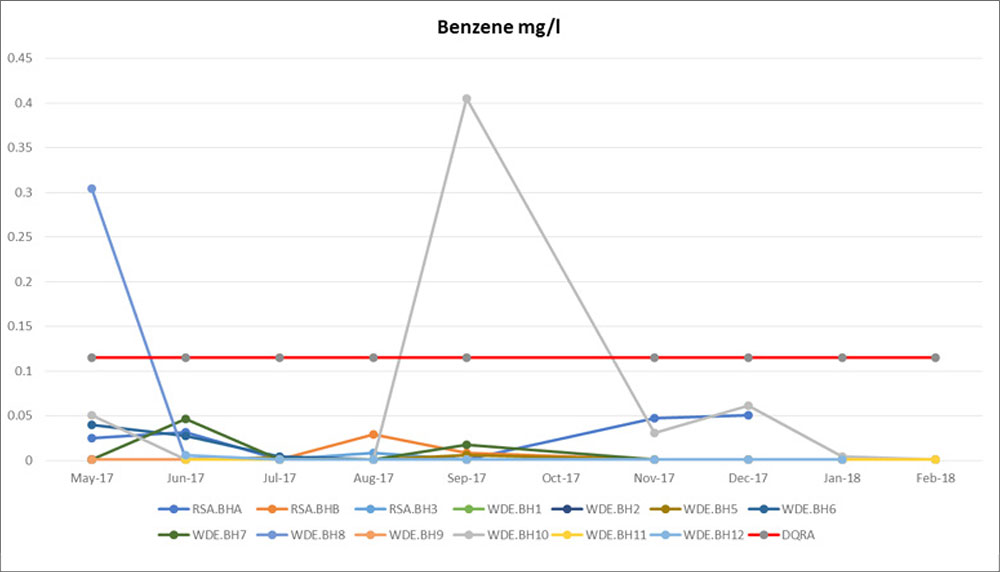
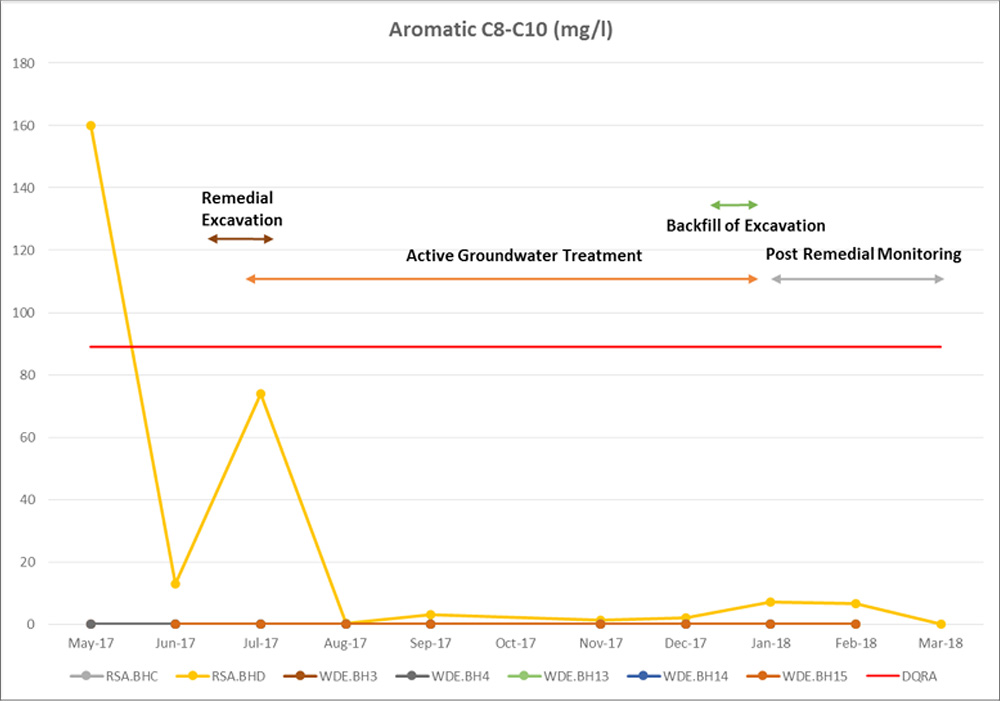
Conclusion
Complimentary remedial technologies were combined successfully to achieve:
- Contaminant mass reduction to below remedial targets in the soil and groundwater within 6 months.
- Protection of onsite and offsite receptors.
- Written confirmation by the Environment Agency that they ‘agree with (the reports’) conclusions’ and that ‘development may proceed’.
- Remediation completed on a tight budget – as remediation had not been foreseen by the developer.
- Ex-Situ remediation of soils and their reuse on site under the CL:AIRE CoP avoided offsite disposal of ~800m3 to landfill.
- In Situ enhancement of the P&T system, minimising the time, cost and volume of abstraction required.
- By combining the technologies intelligently, both simultaneously and sequentially, the programme length was minimised – allowing construction to continue within only 6 months.
Protection of a river using an activated carbon barrier in North Italy
Summary
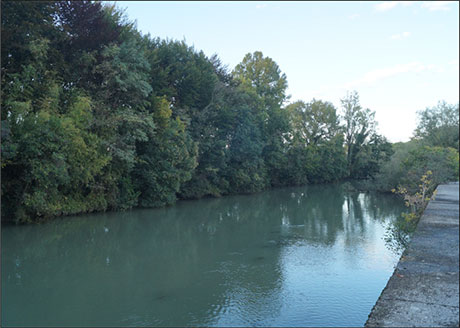 On a 6 hectare site in northern Italy, an extensive enhanced reductive dechlorination process had been previously been carried out by REGENESIS using a combination of proprietary electron donors (3-D Microemulsion and HRCs). This resulted in successfully reducing TCE contamination and its daughter products from high levels (suggesting the presence of some DNAPL) to low dissolved phase concentrations. The concentrations were suitably low to allow regulatory closure of the internal part of the site. This was achieved within 2 years from a single injection. Immediately beyond the downgradient site boundary, a river presents a sensitive receptor. This, plus legislative rules, determine that the site boundary targets are very stringent (<1 μg/L). Although the previous electron-donor application has reduced the contaminant influx dramatically, at such low concentrations, biodegradation alone may not reach these low targets.
On a 6 hectare site in northern Italy, an extensive enhanced reductive dechlorination process had been previously been carried out by REGENESIS using a combination of proprietary electron donors (3-D Microemulsion and HRCs). This resulted in successfully reducing TCE contamination and its daughter products from high levels (suggesting the presence of some DNAPL) to low dissolved phase concentrations. The concentrations were suitably low to allow regulatory closure of the internal part of the site. This was achieved within 2 years from a single injection. Immediately beyond the downgradient site boundary, a river presents a sensitive receptor. This, plus legislative rules, determine that the site boundary targets are very stringent (<1 μg/L). Although the previous electron-donor application has reduced the contaminant influx dramatically, at such low concentrations, biodegradation alone may not reach these low targets.
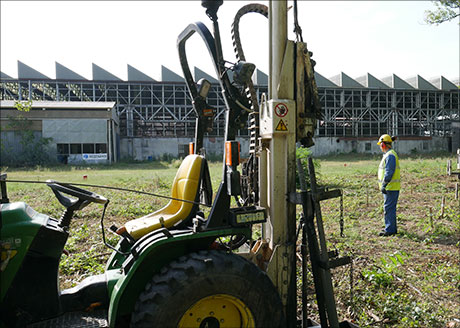
Therefore, a second phase treatment has been implemented in order to enhance the biodegradation process further using PlumeStop, a Liquid Activated Carbon. This application will adsorb the contamination and provide a biomatrix on which the dehalogenating bacteria will come into contact with the chlorinated solvents. This combination of sorption and biodegradation will provide an enhanced reduction in contaminant concentrations, which will then be sustained and further contaminant influx is adsorbed and degraded.
Download the pdf2m 1s reading time
Treatment
PlumeStop was applied in a double pilot test performed in two areas of the site, where different contaminant concentrations were observed. This was useful for demonstrating technology’s efficacy and to design and accurate dose for the full scale treatment. A larger PlumeStop barrier application is now being implemented along the site boundary. This will create a subsurface activated carbon filter along the length of the downgradient boundary. This consists of approx. 150 direct push injection points, performed using two Geoprobe rigs, in parallel. The dosage has been tailored for each sub-area depending on the contamination concentration and heterogeneity of the alluvial subsurface.
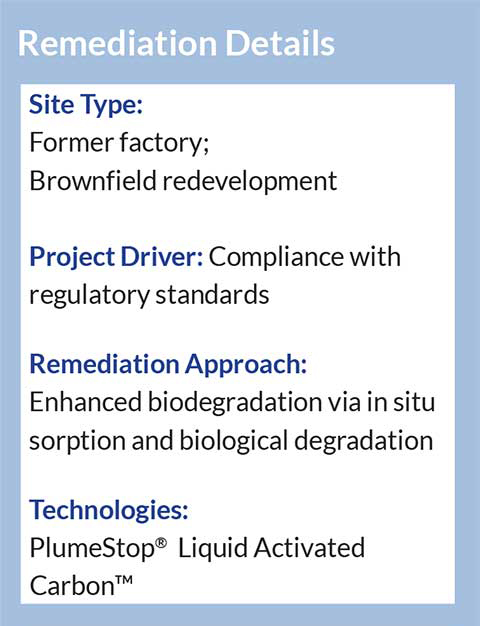
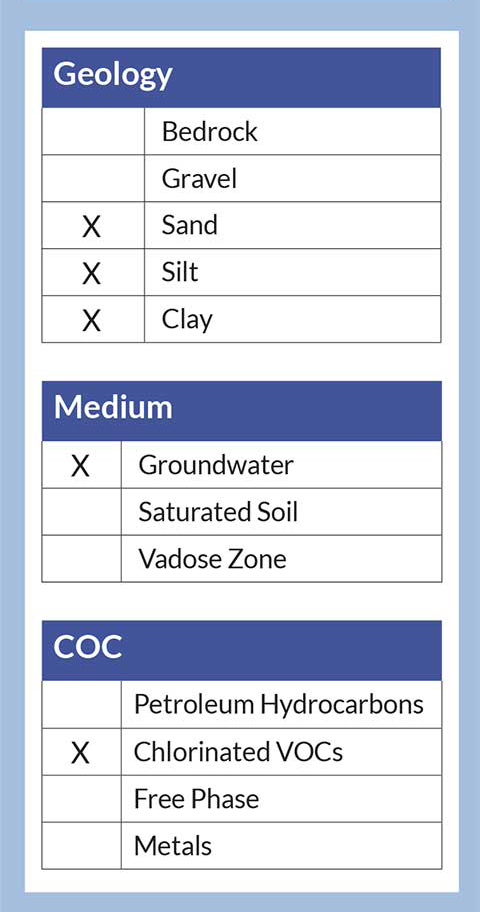
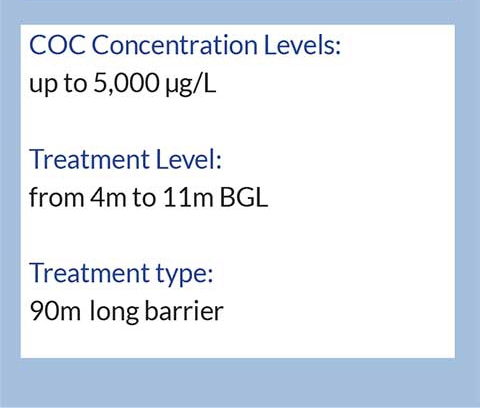
What’s Special
- Unique in situ process allows for fast depletion of residual organic contaminants in order to reach very stringent values using only a single application.
- Bioregeneration of the injected carbon filter is achieved through biodegradation of the sorbed chlorinated compounds: this provides long term treatment (years – decades) from a single application.
- The system will replace a costly Pump & Treat barrier that has worked to hydraulically confine the site for 10 years. This will allow the owner to finally cease all site remediation activities and allow regulatory site closure.
Historic Site On Track To Reach Remediation Goals
 This case study reviews a site in the Ohio River Valley where historic industrial operations over the last 100 years at a manufacturing facility have resulted in PCE and TCE impacts to 7,500 square feet of shallow groundwater. To move the redevelopment of this site forward, groundwater VOC sample results must meet the U.S. Environmental Protection Agency maximum contaminant levels (MCLs) for four consecutive quarters. Download the case study to learn about the combined remedy using PlumeStop, HRC, and BDI+ to address the contaminants.
This case study reviews a site in the Ohio River Valley where historic industrial operations over the last 100 years at a manufacturing facility have resulted in PCE and TCE impacts to 7,500 square feet of shallow groundwater. To move the redevelopment of this site forward, groundwater VOC sample results must meet the U.S. Environmental Protection Agency maximum contaminant levels (MCLs) for four consecutive quarters. Download the case study to learn about the combined remedy using PlumeStop, HRC, and BDI+ to address the contaminants.
This case study features the following:
- Creative combined remedy approach addressed accumulated contaminants from over 100 years of manufacturing operations
- Innovative application approach using 1.5” diameter wells effectively accommodated low ceiling and tight spaces, allowing for successful reagent injection
- 180 days post-injection, all VOCs were measured at greatly reduced concentrations and geochemical conditions remain ideal for biodegradatio
2m 40s reading time
Successful 12-Month Pilot Trial of Enhanced Reductive Dechlorination
With RGS Nordic and Nordic Envicon
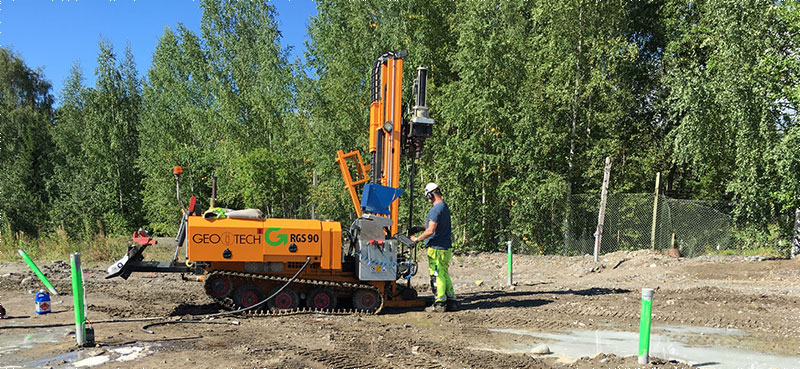
Introduction
![]() REGENESIS were approached by RGS Nordic and Nordic Envicon to form part of a specialist team to design a remedial scheme for a former aerospace factory in Finland.
REGENESIS were approached by RGS Nordic and Nordic Envicon to form part of a specialist team to design a remedial scheme for a former aerospace factory in Finland.
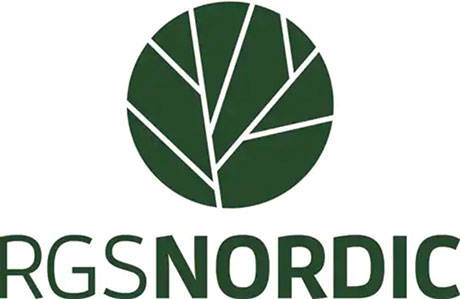 An area of over 100,000m2 is impacted by a chlorinated solvent plume in the groundwater, comprising predominantly cis-1,2-dichloroethylene (DCE) contamination. The first phase of these works comprised a pilot trial, to demonstrate the applicability and efficacy of the suggested treatment method ahead of full-scale deployment.
An area of over 100,000m2 is impacted by a chlorinated solvent plume in the groundwater, comprising predominantly cis-1,2-dichloroethylene (DCE) contamination. The first phase of these works comprised a pilot trial, to demonstrate the applicability and efficacy of the suggested treatment method ahead of full-scale deployment.
Download the PDF 2m 21s reading time
Remediation Approach
The site had many challenges that needed to be overcome in order to deliver a cost-effective scheme of works:
- Complex heterogeneous formation, comprising sands, gravels, silts and crystalline bedrock;
- Extremely large plume (>100,000m2 of which 60,000m2 requires treatment);
- Conflicting seasonal groundwater flow directions;
- Full-scale works will be required to deliver a fully remediated site within two years.



After completing an in-situ remediation option appraisal the team agreed that the full-scale strategy should comprise a series of ‘barriers’ (treatment zones through which groundwater would continue to flow, but in which the contamination would be degraded) perpendicular to groundwater flow.
This configuration would minimize the number of injection points, reducing application costs, without compromising treatment efficiency. The electron donor which was suggested was 3-D Microemulsion® (3DMe).
Fig. 1 – The molecular structure of 3-D Microemulsion
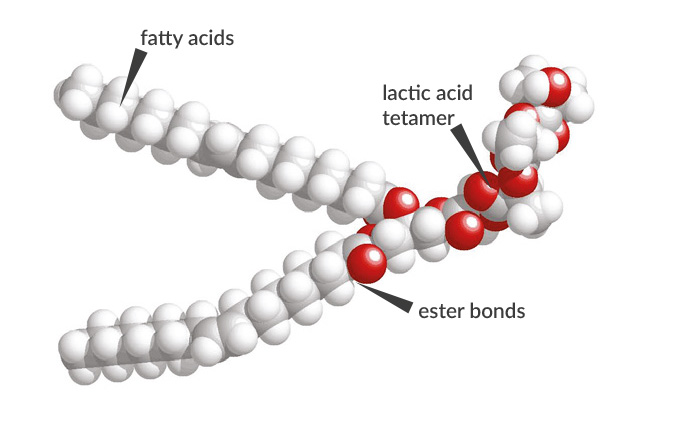
Fig. 2 – The 3 Stage Release profile of 3DMe
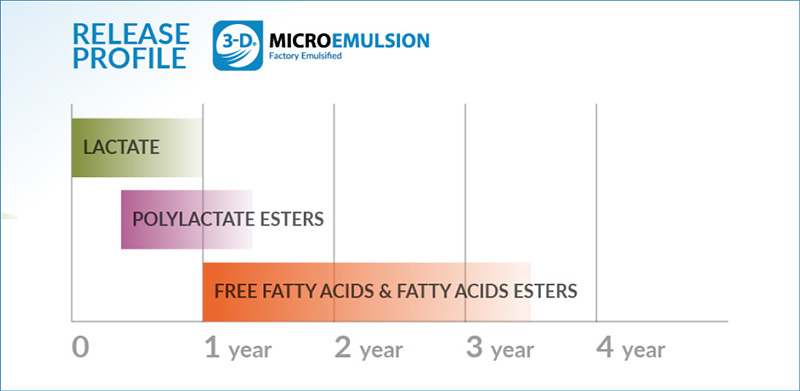
3DMe provides three stages of electron donor release from a single concentrate of specially designed polar molecules. When mixed with water on site, 3DMe forms a high-volume microemulsion, without the requirement of emulsifiers.
Upon injection into the groundwater, 3DMe initially moves out into the formation and adsorbs to the soil particles. As the molecule is designed to be appropriately soluble, it then gradually dissolves back into the groundwater, where it ferments to drive enhanced reductive dechlorination (ERD), but also reaches its critical micelle concentration (300 ppm), reforms as a microemulsion and moves further out from the injection point.
This process repeats to ‘self-distribute’ the 3DMe over large distances within the subsurface, without it washing away. This mechanism allows for wider injection spacing which reduced the number of injection locations.
Fig. 3 – 3DMe micelle representation
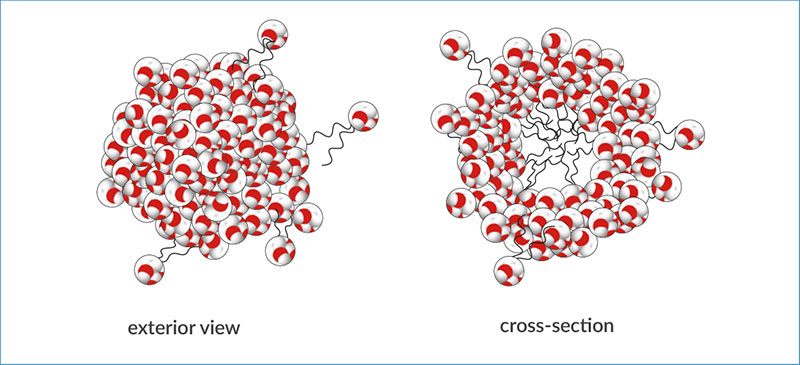
Fig. 4 – Injection configuration
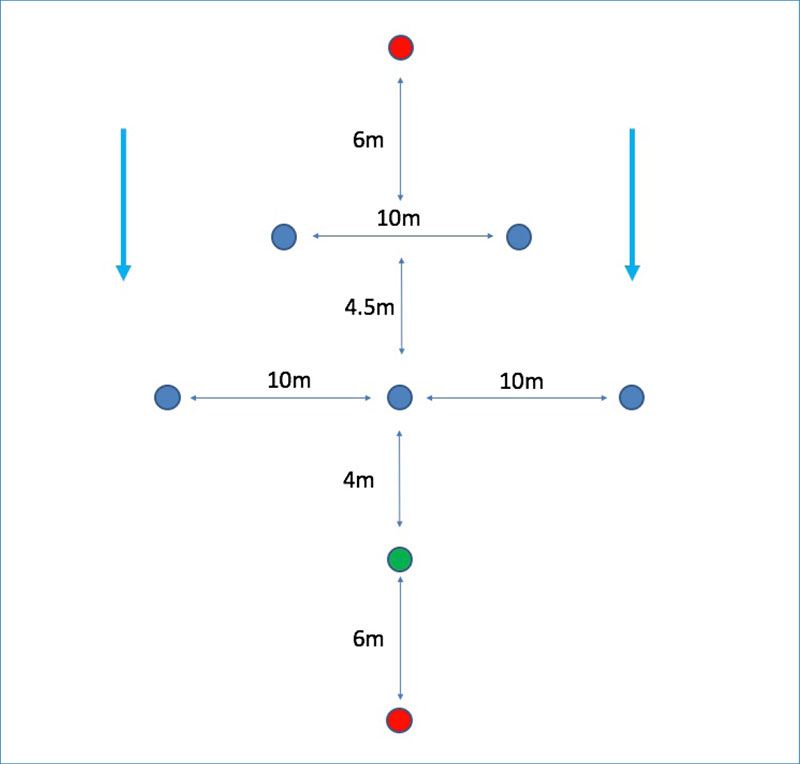
Pilot Trial Application
Prior to a full-scale application being completed, it was determined that a pilot test should be completed. The intention was to determine how well the heterogeneous formation would accept the application, verify the injection spacing and confirm the efficacy of the treatment. A 20m wide barrier was installed perpendicular to groundwater flow. This consists of 5 injection points, forming two rows with 10m spacing within the rows and 4.5m in between rows (see fig. 4) This created an effective injection spacing of 5m perpendicular to groundwater flow.
Direct push injection was used, with the requisite dose of 3DMe injected at each location from 4m BGL (groundwater level) to 10m BGL (top of the competent bedrock).

Fig. 5 – Injection works on site

Fig. 6 – Injection works on site
Results
Validation was completed over 12 months following application. During this period the small amounts of PCE and TCE were reduced in the groundwater to below detection limit. The main cis-1,2-DCE contamination was reduced by 99% to 13μg/L, well below the remedial target of 500μg/L. Sequential production and degradation of daughter products showed that full reductive dechlorination was achieved, with vinyl chloride (VC) concentrations peaking at 280μg/L, but then quickly decreasing to 12μg/L by the end of the validation period. Full reductive dechlorination was also evidenced by the production of ethene throughout the treatment.
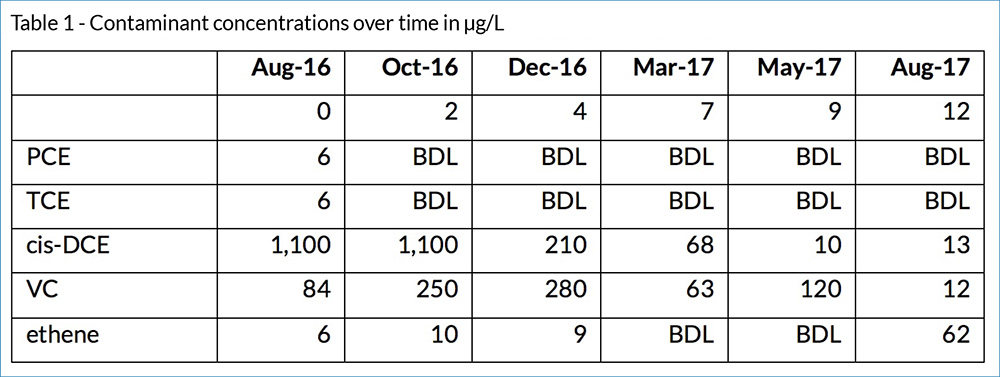
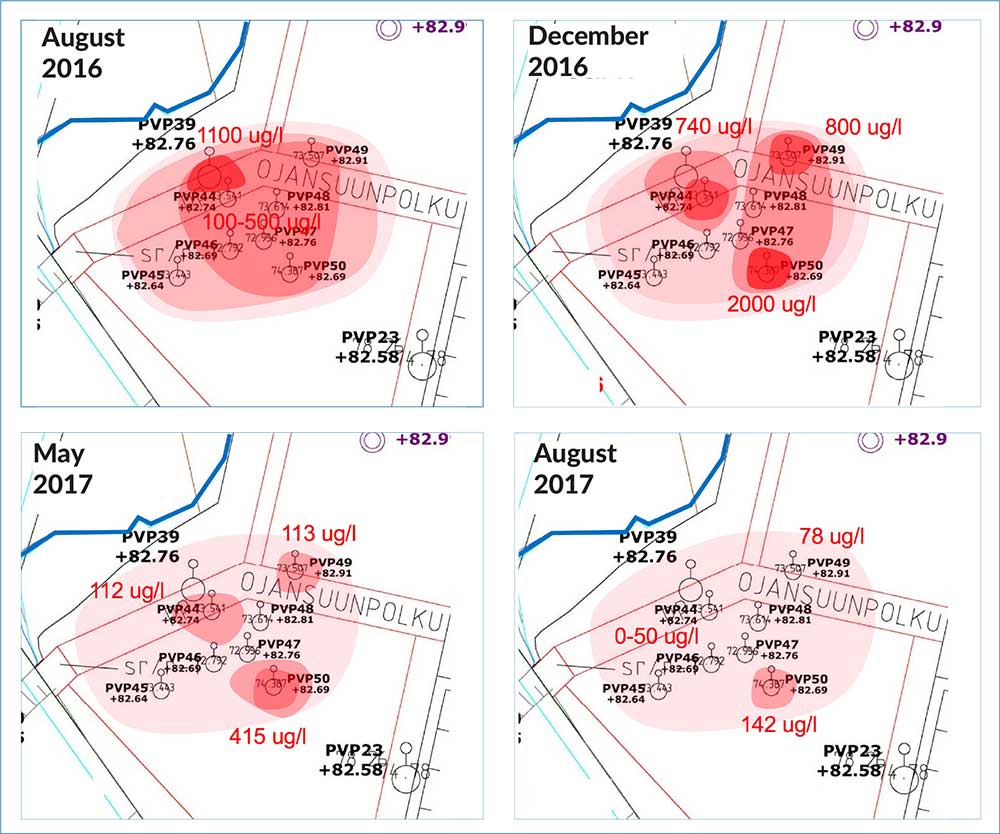
Fig. 7 – Contaminant concentrations plots in target area over time
Fig. 8 – Total CHC concentrations over time
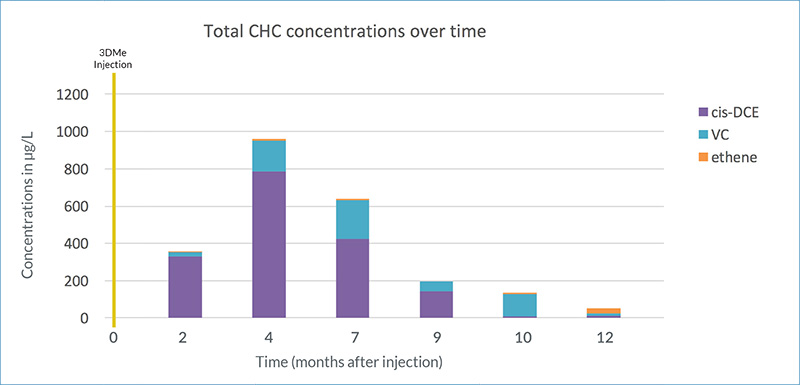
Conclusion
- The pilot trial demonstrated the ability to apply 3DMe on a wide grid in a heterogeneous formation.
- The treatment successfully reduced the contaminant of concern by 98%, well below the remedial target values.
- Full reductive dechlorination of the contaminant was achieved.
- The pilot trial allows for the full scale treatment to be accurately designed and programmed.
Treatment of mixed chlorinated ethenes and ethanes at an active site, UK
Introduction
REGENESIS was approached to offer an in situ remedial solution to address high levels of mixed chlorinated solvent (TCA and TCE) contamination of the groundwater at a site in northeast Scotland. At the time, an ongoing DPVE system was operating, but was unable to achieve the remediation goal of a 75% reduction in chlorinated solvent mass. Furthermore, a supplementary MIP investigation showed that there was more contamination at depth (>6m) which the DVPE system was not able to reach.
Download pdf2m 42s reading time
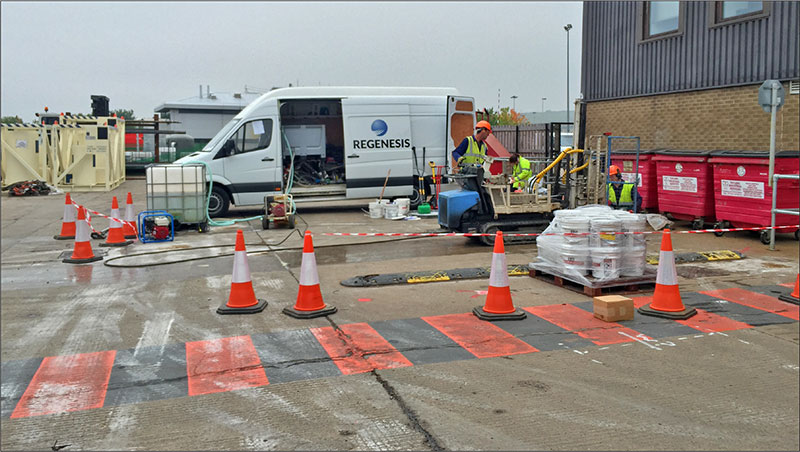 Fig. 1 REGENESIS Remediation Services applying 3DMe and BDI Plus on site
Fig. 1 REGENESIS Remediation Services applying 3DMe and BDI Plus on site
The initial design was based on treatment between 3 – 9m BGL of the aquifer across a 1,200m2 using 3DME and BDI with the preferred method of application being direct push injection. However, during the MIP investigation progression of the rods deeper than 6mBGL was found to be difficult. This raised concerns that (1) direct push injection would not be able to reach 9m BGL and (2) injection of the required dose of 3DMe may not be possible. REGENESIS were therefore asked to undertake a pilot study over a limited area to demonstrate that the works were possible. This was completed successfully and also showed excellent dose response and demonstrated to the site owners that the works (which were completed at night) would not have a deleterious effect on their operations.
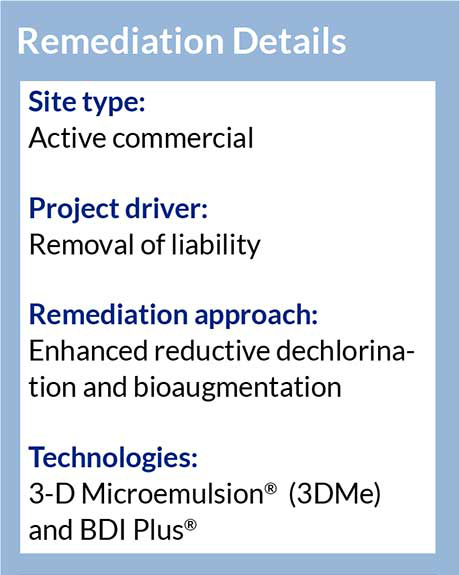
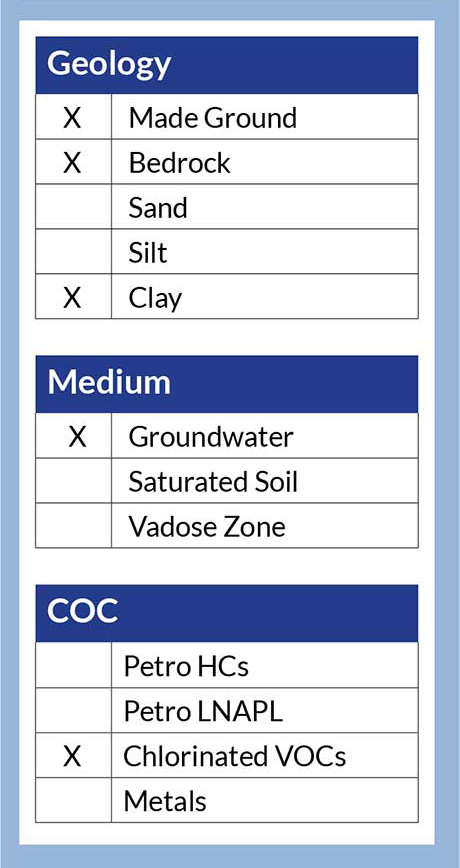
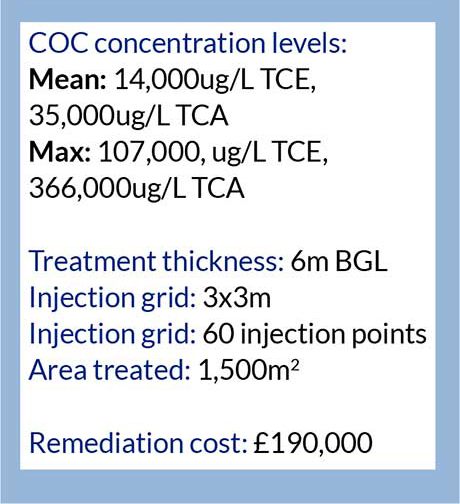
Full Scale Application
The pilot trial was conducted over two days (see figure 1) during which the direct push injection rig had no problems getting the injection rod to the required depth of 9m BGL (unlike the MIP). Furthermore, the required volume of 3DMe was accepted by the aquifer with minimal daylighting/surfacing.
Following the MIP and pilot, the fullscale design was tailored to provide the most cost effective approach for the site. 60 direct push injection points were completed over 10 nights, with no disturbance to the site operations.
The direct push injection points were centred on BH 11, a pre-existing well, to ensure we had good baseline data. Both BH11 and the surrounding wells were monitored over 8 months to assess the effect and distribution of 3DMe.
Results
Following the injection works, quarterly validation monitoring was completed. Post injection monitoring showed no inhibition of parent compound degradation due to the mixed halogenated compound plume. 98% and 99% reduction in mean concentration of TCA and TCE respectively.
Full reductive dechlorination was achieved with no build up in daughter products (see fig 2 and 3). The validation curves suggest that both biotic and abiotic degradation occurred.
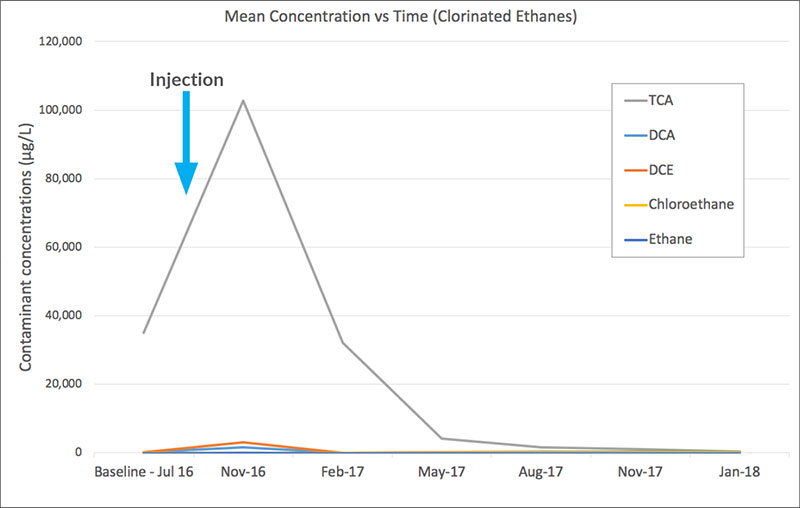
Fig. 2 Mean concentrations of Chlorinated Ethanes over time
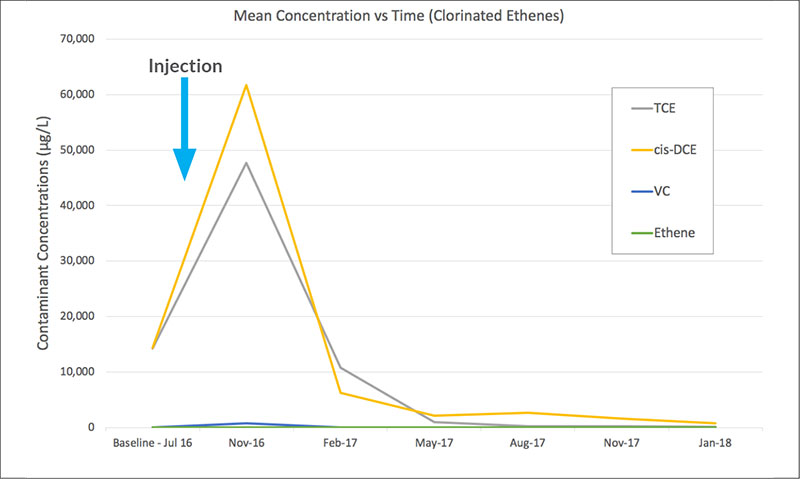
Fig. 3 Mean concentrations of Chlorinated Ethenes over time
Abiotic degradation occurred through the production of reduced iron species by the production of low redox conditions created by the 3DMe.
What’s Special
- A limited pilot study was used to prove the practicality and efficacy of the proposed approach. This area did not require further injection, so added little extra cost to the remediation of the site.
- Bioaugmentation using BDI+ avoided any inhibition of either chlorinated ethenes and ethanes by ensuring that the microbial consortia contained viable counts of dehalogenating bacteria specialising in either contaminant group.
- Very high levels of contamination, suggestive of DNAPL, were reduced to very low concentrations within 18 months.
- No build up of degradation products occurred, showing full reductive dechlorination was achieved and sustained.
- No disturbance of the onsite operations occurred during the limited injection time onsite, with the remediation occurring under the site as it continued to function normally.
- Remediation goals were achieved.
Fig. 4 REGENESIS’s team onsite
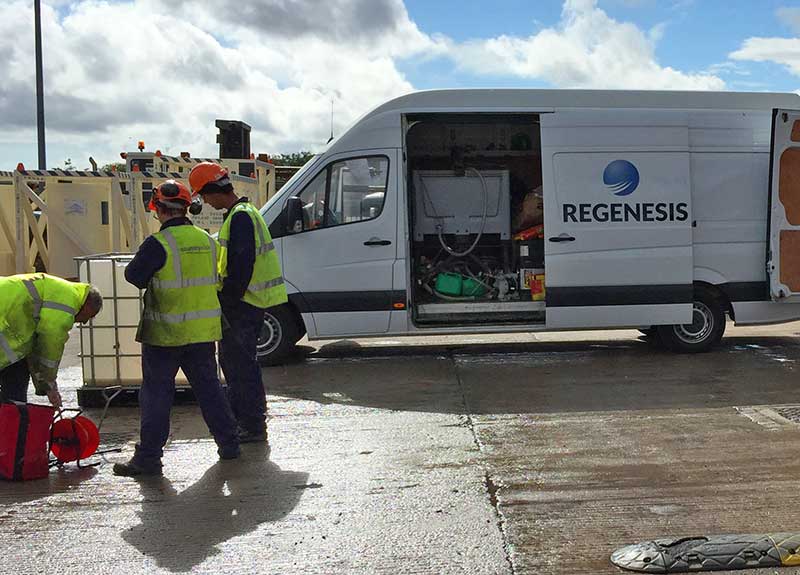
Advanced Remedial Technologies Restore Neighborhood
Former Michigan Industrial Site Treated Using Combined Remedy Approach
This case study reviews a former plating facility in southwest Michigan that had released chlorinated volatile organic compounds (cVOCs) into shallow groundwater, resulting in a ¼-mile long contaminant plume. In response, the Michigan Department of Environmental Quality (MDEQ) and the environmental firm, DLZ, implemented a combined remedy which included mitigating vapor intrusion in the residential basements and treating the groundwater plume with a novel, multi-phase in situ bioremediation approach.
- Application of combined REGENESIS technologies to biodegrade contaminants, prevent further plume migration, and protect occupants from the threat of vapor intrusion.
- Reduction of the total cVOC plume extent by 95% and reduced mass by 99.8%.
- Positive results indicating the degradation process is ongoing and processing.
8m 54s reading time
In Situ Treatment of Dichloroethene and Vinyl Chloride in Brussels, Belgium
Integrated remediation allows for redevelopment of historic industrial site. Read the case study.Read More
Site Goals Achieved Within Two Months
A Former Santa Barbara Manufacturing Facility Treated Using a Combined Remedy Approach
 This case study reviews a contaminated manufacturing site in Santa Barbara, California. A former manufacturing operation had left PCE and TCE contaminant levels above regulatory limits with previous remediation approaches attempted without complete success. Applying a combined remedy approach, Haro Environmental chose to focus on incorporating a design to rapidly reduce contaminant concentrations for sustained treatment, and reduce the potential for further downgradient migration of the PCE and TCE contaminants.
This case study reviews a contaminated manufacturing site in Santa Barbara, California. A former manufacturing operation had left PCE and TCE contaminant levels above regulatory limits with previous remediation approaches attempted without complete success. Applying a combined remedy approach, Haro Environmental chose to focus on incorporating a design to rapidly reduce contaminant concentrations for sustained treatment, and reduce the potential for further downgradient migration of the PCE and TCE contaminants.
This case study features the following:
- This site has been an active case since 2007. REGENESIS was able to eliminate the contaminant quickly and effectively using a combined remedy approach.
- After conducting a pre-field remediation test, the injection interval was reduced from 12 feet to 9 feet with a bottom-up approach, reducing the project costs by 30%.
- The combination of PlumeStop, HRC and BDI+ successfully eliminated the contaminants and created conditions for sustained treatment at the site.
5m 22s reading time

 Americas
Americas Europe
Europe Français
Français Deutsch
Deutsch Italiano
Italiano Español
Español

